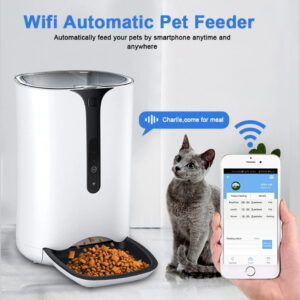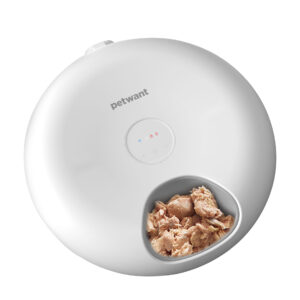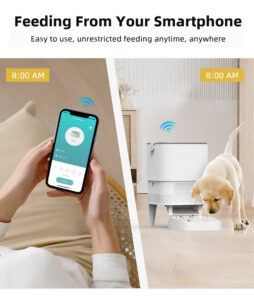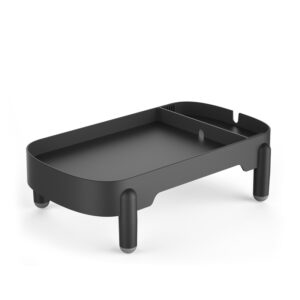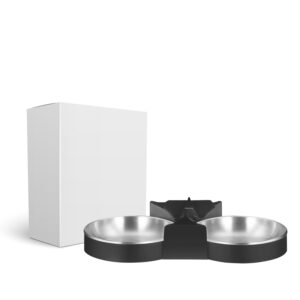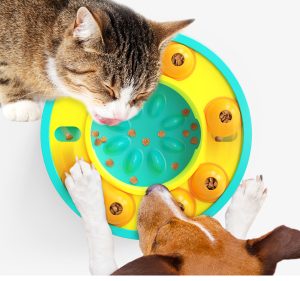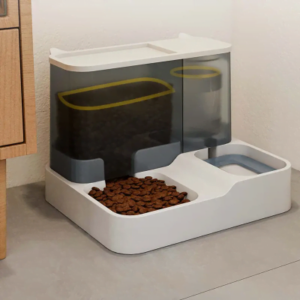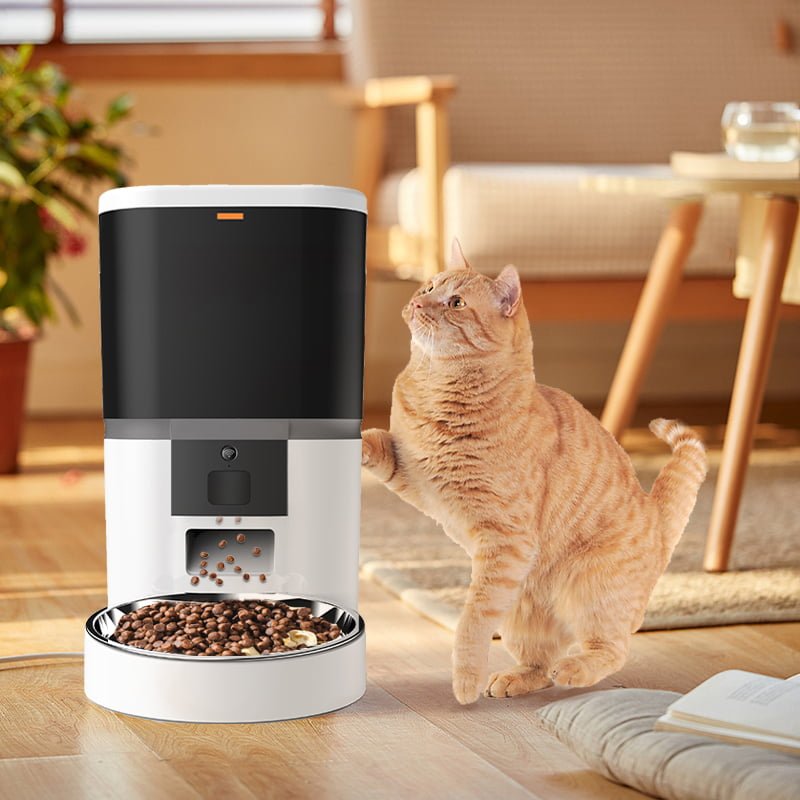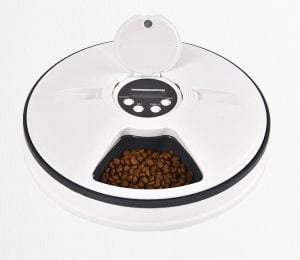Feeding During Loadshedding: Smart Strategies for South African Pet Owners
South Africa’s rolling blackouts don’t have to disrupt your pet’s routine. If you’ve wondered how to feed pets during loadshedding, you’re in the right place. This guide pulls together practical, South Africa-specific tips for Stage 2 through Stage 8, with clear answers about automatic feeders, gravity options, wet food safety without a fridge, and daily water needs.
—
Do Automatic Pet Feeders Work During Loadshedding?
Yes. Quality automatic feeders store your schedule internally, so they keep feeding on time even when the power or Wi-Fi drops. Many models include battery backup so the motor can still dispense portions during an outage. Once power returns, the device resumes normal operation without losing your plan.
What about Wi-Fi? Once your timetable is saved, scheduled feeds run offline. Wi-Fi is only needed for app updates, viewing logs, or video features.
Power solutions mini-guide:
- AA battery backup (common on many feeders): typically powers scheduled feeds for 1–3 months, model and usage dependent.
- Small UPS/inverter or power bank (via USB where supported): can keep a feeder running for several days of scheduled feeds.
- Best practice: save your schedule, insert fresh batteries, and do a test feed in “airplane mode” to confirm offline behaviour.
- Safety tip: secure the feeder on a stable surface and tidy cables to avoid tugs during dark outages.
Note: Always check the product page for exact battery type, runtime estimates, and whether USB power/UPS use is supported.
—
Best Battery-Backup Auto Feeders in South Africa (Comparison)
Looking for the best automatic pet feeder with battery backup in South Africa? Here’s a quick, human-friendly comparison to help you shortlist. For detailed specs, open each product page and check capacity, battery type, and offline features.
- Elegant Connected Auto Feeder
– Ideal for: Cats and small/medium dogs that need precise portions. – Highlights: App scheduling with offline feeding once saved; portion control; works during power cuts with battery backup (model dependent). – Tip: Pair with a small UPS if you also want camera or Wi-Fi features active during outages.
- Classic Connected AutoFeeder
– Ideal for: Daily 1–4 scheduled feeds, simple setup. – Highlights: Reliable timed portions; runs schedules without Wi-Fi; battery option available on select models.
- Wet Pet Food Dispenser
– Ideal for: Pets on wet or mixed diets who need timed access. – Highlights: Timed compartments; use with ice packs to keep wet food cooler; battery operation on many designs.
Want side-by-side specs (capacity, backup type, offline mode, portion size)? Tap “Compare Models” on each product page.
—
Gravity Feeders: Simple, Power-Free Feeding
If you prefer a no-fuss option, gravity feeders are perfect during power cuts. They use gravity to refill the bowl as your pet eats—no electronics, no schedules to lose.
Pros:
- Zero electricity, zero Wi-Fi
- Budget-friendly and low-maintenance
- Great for cats that like to graze
Considerations:
- Not ideal for pets that tend to overeat
- Works best with consistent-calorie, high-quality kibble
- Use a portion control scoop for top-ups and monitor weight weekly
Compare: gravity feeder vs automatic feeder during power cuts
- Choose gravity if your pet self-regulates and you want simplicity.
- Choose automatic if you need measured portions, medication timing, or strict schedules (diabetic, senior, or weight-management pets).
—
Keep Wet Food Safe Without a Fridge
Wet and raw foods are the first to suffer when the power goes off. Keep meals safe and fresh with these strategies:
- Use single-serve pouches/cans to avoid storing open food.
- If you must store opened wet food, keep it on ice in a camping cooler and aim to use within 24 hours.
- Time limits at room temp: discard opened wet food left out for more than 2–4 hours (sooner in summer heat).
- Try shelf-stable options like complete freeze-dried meals or toppers during frequent outages.
- For timed wet feeding, use a dispenser with an ice pack insert (and label each compartment).
Pro tip: Pre-portion wet meals into small containers in the morning and keep them in an insulated bag with ice packs. Rotate packs every few hours during Stage 6–8.
—
Hydration Tips During Power Cuts
Water access matters just as much as food—especially during hot afternoons and when municipal pumps are affected by outages.
Daily water needs (typical guidance):
- Dogs: around 50–60 ml per kg body weight per day.
- Cats: around 40–50 ml per kg per day (many get some moisture from food).
Keep water clean and available:
- Use a gravity waterer sized to your pet and household (3–6 L for multi-pet homes is a good starting point).
- Store at least a 2–3 day backup of bottled or filtered water for each pet.
- Position bowls away from direct sun; consider an insulated or cooling bowl to keep water fresh.
- Rinse and refresh bowls frequently, especially in warm rooms during loadshedding.
Related pick: Cool Bowl for naturally cooler water and slower warming during power cuts.
—
Plan Your Pet’s Meals Around the Loadshedding Schedule
A little planning goes a long way. Check the weekly schedule and build your pet’s routine around the gaps.
Where to check:
- Eskom load shedding schedule: https://www.eskom.co.za
- City pages:
– City of Cape Town: https://www.capetown.gov.za – City Power Johannesburg: https://www.citypower.co.za – eThekwini/Durban: https://www.durban.gov.za
Simple templates:
- Cats (grazers):
– Gravity feeder topped up mornings and evenings. – For auto feeders: two small scheduled portions during known power-on windows, plus a small late snack if needed.
- Dogs (1–2 meals/day):
– 2-meal plan: Feed 06:30–07:30 and 18:30–19:30. If Stage 6 pushes your evening slot into darkness, pre-portion and use battery-backed scheduling. – 1-meal plan: Feed mid-morning when power and light are predictable; add a small evening topper if routine is disrupted.
Travel or late shifts? Save your schedule to the feeder and keep spare batteries ready. Add a phone reminder 10 minutes before a planned feed during Stage 6/8.
—
Manual Portion Planning (HowTo)
Prefer hands-on control or facing extended outages? Here’s a quick, reliable method.
What you’ll need:
- Measuring cup or kitchen scale
- Zip bags or small reusable containers
- Permanent marker
- Cooler bag + ice packs (for wet food days)
Steps: 1) Weigh or measure each meal according to your vet’s guidance. 2) Pack and label by day and time (e.g., “Mon AM,” “Mon PM”). 3) Store kibble in a cool, dry place. Keep wet meals in a cooler with ice packs. 4) During outages, remove only what you’ll serve in the next 2–4 hours. 5) Log appetite and leftovers to spot any stress-related changes.
—
Medical and Special Cases
Some pets cannot miss a beat.
- Diabetic pets: Timed feeding tied to insulin is essential. Use an automatic feeder with battery backup, set duplicate alarms on your phone, and keep syringes/insulin in a cooler with temperature packs during long outages.
- Seniors and pets on meds: Smaller, more frequent meals can reduce stomach upset. Pre-portion and set gentle reminders.
- Sensitive stomachs: Stick to the same brand and recipe; avoid last-minute diet changes during Stage 6/8 weeks.
Always consult your vet for personalised schedules and medication timing.
—
Emergency Feeding Checklist
Print or download this and stick it to your fridge.
Food and water:
- 2 weeks of dry or shelf-stable pet food
- Single-serve wet cans/pouches (if used)
- Gravity waterer + 2–3 days of emergency bottled water per pet
Gear:
- Automatic feeder with fresh batteries (or UPS/power bank if supported)
- Measuring cup/kitchen scale; labelled meal containers
- Cooler box with ice packs for wet food or meds
- Torches/headlamp for safe scooping at night
Admin:
- Saved outage timetable for your area
- Vet contact and written feeding/medication plan
- Back-up caregiver instructions
—
FAQ: Feeding During Loadshedding
Q: Do automatic pet feeders work during loadshedding? A: Yes—models with battery backup keep your schedule and dispense on time. Schedules are stored on the device so feeding continues without mains power.
Q: Do auto feeders need Wi-Fi to feed? A: No. Once your schedule is saved, feeding runs offline. Wi-Fi is only needed for app updates and monitoring.
Q: How long will a battery-backup feeder last? A: It depends on the model and battery type. AA-powered units typically run 1–3 months on scheduled feeds; a small UPS/power bank can keep some feeders running for several days.
Q: How can I keep wet pet food safe without a fridge? A: Use single-serve packs, a cooler with ice packs, and discard opened wet food after 2–4 hours at room temperature (earlier in summer heat).
Q: How much water does my pet need daily? A: Dogs need roughly 50–60 ml/kg/day; cats 40–50 ml/kg/day. Increase during hot weather or after exercise.

